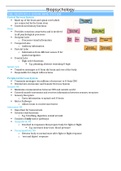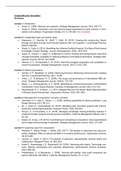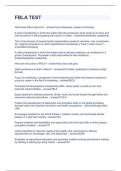DUE DATE 02 OCTOBER 2024
1.1 Explain what is understood by prenatal development in your own words.
Prenatal development refers to the process of growth and development of a fetus inside the womb from
conception until birth. It encompasses several stages, beginning with fertilization when a sperm cell
merges with an egg cell. This initial stage leads to the formation of a zygote, which then embarks on a
complex journey through cell division and differentiation. As the pregnancy progresses, the developing
organism transitions through distinct periods, namely the germinal stage (first two weeks), the
embryonic stage (weeks three to eight), and the fetal stage (week nine until birth). Throughout these
stages, vital systems and structures, such as the heart, brain, and limbs, form, providing the foundation
for a healthy newborn.
### Reference:
- Moore, K. L., Persaud, T. V. N., & Torchia, M. G. (2018). *Before We Are Born: Essentials of Embryology
and Birth Defects*. Elsevier.
1.2 Identify and explain the three phases of prenatal development in your own words.
Prenatal development is typically divided into three main phases: the germinal stage, the embryonic
stage, and the fetal stage. Here’s a brief overview of each phase in simpler terms:
1. Germinal Stage (Weeks 1-2) : This is the very beginning of pregnancy, starting right after conception.
During this phase, the fertilized egg, now called a zygote, undergoes rapid cell division as it travels down
the fallopian tube toward the uterus. When it reaches the uterus, the zygote implants itself into the
uterine lining. This stage is crucial as it sets the foundation for the rest of development. Problems during
this phase can lead to failed implantation and result in early miscarriage.
2. Embryonic Stage (Weeks 3-8): After implantation, the developing organism is referred to as an
embryo. This phase is critical as the major organs and body systems begin to form. The heart, brain, and
spinal cord start developing during this time. Additionally, the embryo goes through significant
structural changes, including the formation of the placenta, which provides nutrients and oxygen to the
developing baby. This stage is particularly vulnerable to environmental influences, such as teratogens,
which can cause birth defects.
3. Fetal Stage (Weeks 9-40): This is the final phase of prenatal development, where the embryo is now
called a fetus. The major development during this phase focuses on growth and maturation. The organs
that were formed in the embryonic stage continue to develop and refine their functions. By the end of
this stage, the fetus will have developed the capacity to survive outside the womb, with fully formed






